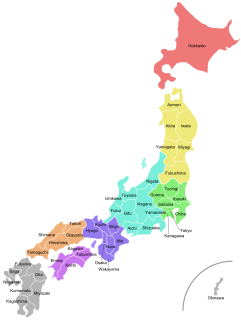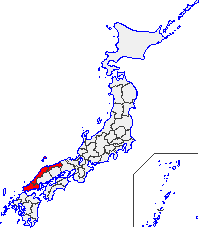 W
WJapan is divided into eight regions. They are not official administrative units, though they have been used by government officials for statistical and other purposes since 1905. They are widely used in, for example, maps, geography textbooks, and weather reports, and many businesses and institutions use their home regions in their names, for example Kinki Nippon Railway, Chūgoku Bank, and Tōhoku University.
 W
WThe Central Highland , or Koshin Region , is an inland region on central Honshū in Japan. It forms the central part of the Chūbu region.
 W
WGokishichidō was the name for ancient administrative units organized in Japan during the Asuka period, as part of a legal and governmental system borrowed from the Chinese. Though these units did not survive as administrative structures beyond the Muromachi period (1336–1573), they did remain important geographical entities until the 19th century. The Gokishichidō consisted of five provinces in the Kinai (畿内) or capital region, plus seven dō (道) or circuits, each of which contained provinces of its own.
 W
WHokurikudō is a Japanese geographical term. It means both an ancient division of the country and the main road running through the old Japanese geographical region. Both were situated along the northwestern edge of Honshū. The name literally means 'North Land Way'. It also refers to a series of roads that connected the capitals of each of the provinces that made up the region.
 W
WThe Iya Valley region in Tokushima Prefecture, Japan is a scenic area known for its dramatic mountain valleys, thatched roof farmhouses and historic vine bridges. Although access has improved in recent years, the Iya Valley and the inner parts of Shikoku have historically been remote and difficult to enter, making them a favorite retreat for refugees and defeated warriors. Most notably, members of the Taira clan were rumored to have entered the area after losing the Genpei War to the Minamoto clan in the late 12th century.
 W
WKinai is a Japanese term denoting an ancient division of the country. Kinai is a name for the ancient provinces around the capital Nara and Heian-kyō. The five provinces were called go-kinai after 1760.
 W
WThe 47 prefectures of Japan, which form the first level of jurisdiction and administrative division of Japan, consist of 43 prefectures proper, two urban prefectures , one "circuit" or "territory" and one "metropolis" . The Meiji Fuhanken sanchisei administration created the first prefectures to replace the provinces of Japan in 1868.
 W
WNankaidō is a Japanese geographical term. It means both an ancient division of the country and the main road running through it. The road connected provincial capitals in this region. It was part of the Gokishichidō system.
 W
WThe San'in Region is an area in the southwest of Honshū, the main island of Japan. It consists of the northern part of the Chūgoku region, facing the Sea of Japan.
 W
WSan'indō (山陰道) is a Japanese geographical term. It means both an ancient division of the country and the main road running through it. San'in translates to "the shaded side of a mountain", while dō, depending on the context, can mean either a road, or a circuit, in the sense of delineating a region. This name derives from the idea that the northern side of the central mountain chain running through Honshū was the "shaded" side, while the southern side was the "sunny" side. The pre-modern region corresponds for the most part with the modern conception of the San'in region.
 W
WThe Sanriku Coast is a coastal region on the Pacific Ocean, extending from southern Aomori Prefecture, through Iwate Prefecture and northern Miyagi Prefecture in northeastern Honshū, which is Japan's main island. The name comes from the historical region of Sanriku, referring to the former provinces of Rikuō, Rikuchū and Rikuzen.
 W
WThe San'yō Region is an area in the south of Honshū, the main island of Japan. It consists of the southern part of the Chūgoku region, facing the Seto Inland Sea. The name San'yō means "southern, sunny (yō) side of the mountains" and contrasts with the San'in or "northern, shady (in) side of the mountains".
 W
WSan'yōdō (山陽道) is a Japanese geographical term. It means both an ancient division of the country and the main road running through it. The San'yōdō corresponds for the most part with the modern conception of the San'yō region. This name derives from the idea that the southern side of the central mountain chain running through Honshū was the "sunny" side, while the northern side was the "shady" side.
 W
WThe Setouchi Region , or simply Setouchi, is a geographic region of Japan. Setouchi includes the Seto Inland Sea and the coastal areas of Honshū, Shikoku, and Kyūshū, three of the four main islands of Japan.
 W
WThe Tōkaidō is a Japanese geographical term. It means both an ancient division of the country and the main road running through it. It is part of the Gokishichidō system.
 W
WTōsandō is a Japanese geographical term. It means both an ancient division of the country and the main road running through it. It is part of the Gokishichidō system. It was situated along the central mountains of northern Honshu, Tōhoku region.